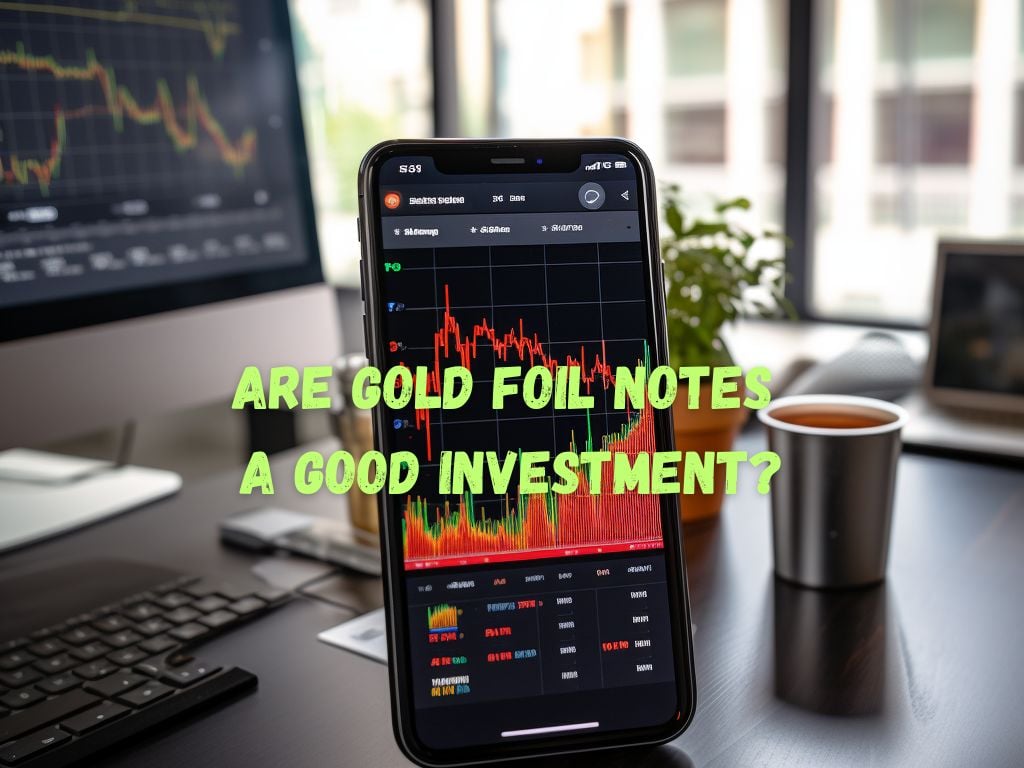Gold foil notes, often hailed as a unique and intriguing investment option, have gained popularity among both seasoned investors and newcomers to the financial world.
But, are gold foil notes a good investment?
In this comprehensive guide, we will explore the pros and cons of investing in gold foil notes, helping you make an informed financial decision.
We will delve into the potential returns, risks, market trends, and provide key insights to guide you on your investment journey.
Definition of Gold Foil Notes
Gold foil notes, also known as gold leaf notes or gold banknotes, are a form of collectible currency that incorporates a thin layer of gold foil onto a traditional paper banknote.
The gold foil is typically applied to specific sections, such as the emblem, symbol, or prominent features, giving the banknote an aesthetically appealing and valuable appearance.
Are Gold Foil Notes A Good Investment?
Gold foil notes can be a unique and appealing investment option, but they come with risks. It’s crucial to consider factors like liquidity and market fluctuations before investing.

Pros of Investing in Gold Foil Notes
Potential for Diversification:
Gold foil notes offer an opportunity to diversify your investment portfolio beyond traditional assets like stocks and bonds.
By investing in tangible assets like gold foil notes, you can potentially reduce the overall risk of your investment portfolio.
Tangible Asset with Intrinsic Value:
Gold has been recognized as a valuable asset for centuries, and gold foil notes bring that inherent value into a portable and collectible form.
The combination of gold and collectible currency creates a unique investment proposition.
Protection against Inflation:
Gold has historically been seen as a hedge against inflation, as its value tends to rise during times of economic uncertainty and currency devaluation.
Investing in gold foil notes allows you to safeguard your wealth against potential inflationary pressures.
Portability and Divisibility:
Gold foil notes are highly portable compared to physical gold bars or coins, making them easier to store and transport.
With gold foil notes, you can invest in smaller denominations, providing greater flexibility when it comes to buying or selling.

Cons of Investing in Gold Foil Notes
Volatility and Market Risk:
Like any investment, gold foil notes are subject to market fluctuations, which means the value of your investment can rise or fall.
The price of gold foil notes can be influenced by factors such as supply and demand, economic conditions, and geopolitical events.
Lack of Liquidity Compared to Other Investments:
Selling gold foil notes may not be as straightforward as selling stocks or bonds. Finding buyers and determining a fair price can take time.
This lack of liquidity can pose challenges if you need immediate access to funds.
Limited Earning Potential:
While gold foil notes can appreciate in value over time, the potential returns may not match those of other high-growth investments like stocks or cryptocurrency.
Investing in gold foil notes is often considered a long-term strategy rather than a quick profit-making venture.
Counterfeit Concerns:
Due to their collectible nature, gold foil notes may be susceptible to counterfeiting.
It is crucial to acquire gold foil notes from reputable dealers who ensure authenticity, as counterfeit notes can result in a significant loss.
Historical Performance of Gold Foil Notes
Historically, gold foil notes have shown mixed performance as investments. While some notes have seen significant gains in value over time, others have decreased in value or remained stagnant.
It’s important to note that the value of gold foil notes can depend on several factors, including rarity, demand, and market trends.
For example, some limited-edition gold foil notes have seen significant appreciation in value due to their rarity and demand from collectors.
Additionally, some notes that feature popular or historically significant designs or themes may also command higher prices.
However, it’s also essential to consider the risks associated with investing in gold foil notes.
Factors like shifts in market trends and changes in collector tastes can result in decreased demand and lower prices.
Additionally, as with any investment, there’s always the risk that a note’s value could decrease, resulting in a loss for the investor.
It’s also important to consider the lack of liquidity associated with gold foil notes as an investment.
While some notes may sell quickly and command high prices, others may take longer to find a buyer. Investors looking to invest in gold foil notes should be prepared to hold the investment for an extended period and understand and accept the risks associated with this type of investment.
Overall, while there have been instances of significant returns on investment in gold foil notes, this type of investment is not without its risks.
Conducting thorough research, understanding the market trends and collector preferences, and being prepared to hold the investment for an extended period are all crucial considerations when evaluating gold foil notes as a potential investment option.

Factors to Consider Before Investing
Before diving into gold foil note investments, it is essential to consider a few key factors:
Financial Goals and Risk Tolerance:
Assess your investment goals, whether they are short-term or long-term, and determine your risk tolerance.
Understand that gold foil notes may be a lower-risk and potentially lower-return investment compared to more volatile assets.
Market Analysis and Trends:
Monitor market trends and assess the demand and liquidity of gold foil notes.
Stay updated on economic indicators, geopolitical events, and overall market sentiment to make informed investment decisions.
Evaluation of the Specific Gold Foil Notes:
Perform due diligence on the specific gold foil notes you are considering.
Research the issuing country, historical significance, scarcity, and condition of the notes to determine their potential value.
Comparisons with Other Investment Options:
Compare the potential returns, risks, and liquidity of gold foil notes with other investment options available to you.
Consider consulting with a financial advisor to gain a comprehensive view of your investment portfolio.
Tips for Making Smart Investment Decisions
Research Reputable Dealers:
Deal with established and reputable dealers who specialize in gold foil notes.
Read customer reviews and verify their credentials to ensure trustworthy transactions.
Understand Pricing and Premium Factors:
Familiarize yourself with the factors that influence the pricing of gold foil notes, such as gold content, rarity, condition, and historical significance.
Be aware of premiums charged for certain designs, limited editions, or special features.
Consider Storage and Insurance Options:
Ensure you have a secure storage solution for your gold foil notes, such as a safe deposit box or a reputable storage facility.
Consider getting insurance coverage to protect your investment against theft, damage, or loss.
Consult with a Financial Advisor:
Seek guidance from a qualified financial advisor who can provide personalized advice based on your financial goals, risk tolerance, and overall investment strategy.
A financial advisor can help you assess the suitability of gold foil notes within the context of your broader investment portfolio.

Frequently Asked Questions
Why invest in gold foil notes?
Gold foil notes offer a unique combination of collectible value and the intrinsic appeal of gold. They can serve as a tangible asset during times of economic uncertainty.
Are there different types of gold foil notes available in the market?
Yes, there are several types of gold foil notes available in the market, including commemorative notes, limited-edition notes, and special issue notes.
How do market trends and demand affect the value of gold foil notes?
Like other collectibles and investments, the value of gold foil notes can be influenced by market trends and demand. Increased demand can drive up prices, while a decline in demand can result in a decrease in value.
Can gold foil notes be considered a long-term investment?
Gold foil notes can be considered a long-term investment depending on the note’s collectability, rarity, and demand.
However, it’s essential to conduct thorough research and understand the risks associated with this type of investment.
Are there any tax implications when investing in gold foil notes?
The tax implications of investing in gold foil notes can vary depending on the note’s classification as a collectible and the investor’s country of residence.
It’s recommended to consult with a tax professional to understand the tax implications in detail.
Conclusion
Investing in gold foil notes can be an exciting endeavor, providing an opportunity to diversify and safeguard your investment portfolio.
As with any investment, it is crucial to carefully weigh the pros and cons, conduct thorough research, and seek professional advice.
By understanding the elements that shape the value of gold foil notes and considering your unique financial goals, risk tolerance, and market trends, you can make an informed decision that aligns with your investment strategy.
Remember, due diligence and informed decisions are key to successful investment outcomes.


 Tags:
Tags:










